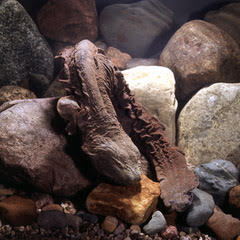
|
Support Hellbenders and Other Endangered Ohio Wildlife with Income Tax Donation
COLUMBUS, Ohio – Reaching 2 feet long and covered in folds of wrinkled skin, the eastern hellbender looks more like a creature from a science fiction movie than one of Ohio’s native species. Hellbenders are an endangered species in Ohio, but thanks to work by the Ohio Department of Natural Resources (ODNR) Division of Wildlife and partnering organizations, hellbenders are returning to our waterways through release efforts, habitat restoration, and watershed protection.
Ohioans can help eastern hellbenders and other vulnerable wildlife by donating all or a portion of this year’s state income tax refund. By making a tax donation to the Wildlife Diversity Fund, Ohioans are helping to ensure the future of Ohio’s ecosystems, from native habitats and landscapes to endangered plant and wildlife species.
Funds from the tax donation program go directly to projects that protect Ohio’s wildlife. Individuals may donate by entering a dollar amount for “Wildlife Species” on line 26d of the 2020 IT 1040 tax form. Contributions made on the 2020 tax return and filed in 2021 are considered deductible donations made in 2021.
The eastern hellbender is Ohio’s largest amphibian and some may live more than 60 years. These secretive salamanders are susceptible to poor water quality and excessive siltation of streams. The dedicated work of the Division of Wildlife and its partners to restore hellbenders, along with improved water quality stemming from the Clean Water Act, has yielded some success restoring hellbenders in Ohio’s stream and rivers. Keeping Ohio’s streams clean and healthy is essential not just for hellbenders, but for the benefit of all Ohioans.
A major milestone was reached in 2019 when the 1,000th hellbender was released into a southern Ohio stream. The Toledo and Columbus zoos and PENTA Career Center in Toledo raised juvenile animals from eggs collected in the wild, releasing them at three years old when they are less susceptible to predation. Biologists plan to release 300 of these salamanders each year so they can establish breeding, self-sustaining populations in the wild.
In hope that hellbenders can one day be removed from Ohio’s list of endangered species, biologists also place hellbender huts — concrete structures that mimic preferred habitat — in streams to augment recovery efforts. Ohioans can browse the free Amphibians of Ohio Field Guide to learn more abouthellbenders and other important amphibian species in Ohio.
Because hellbenders are dependent on high-quality stream habitats throughout the year, conserving this space is key to ensuring their continued success. Ohio Governor Mike DeWine’s H2Ohio program is working to establish buffer strips along stream banks to reduce the amount of nutrients and sediment from agricultural fields that enter waterways. H2Ohio is also building and restoring headwater wetlands that help purify water before it enters streams. The H2Ohio program is bringing Ohioans better quality water in rivers, streams, and Lake Erie, as well as helping wildlife.
The Division of Wildlife is responsible for conserving and improving fish and wildlife resources in the Buckeye State. Follow the Division of Wildlife onTwitter and Facebook for instant news stories, outdoor recreation ideas, local wildlife information, and so much more.
The Your Wild Ohio Explorer page provides wildlife success stories and ways to help wildlife throughout the seasons. Visit wildohio.gov to find locations to hunt, fish, trap, and view wildlife. Follow us on Instagram to view the best of Ohio’s wildlife photography. And don’t forget about the HuntFish OH mobile app, available for Android and iOS users through the app store.
The mission of the Division of Wildlife is to conserve and improve fish and wildlife resources and their habitats for sustainable use and appreciation by all. Visit wildohio.gov to find out more.
ODNR ensures a balance between wise use and protection of our natural resources for the benefit of all. Visit the ODNR website at ohiodnr.gov.
-30-For more information, contact:
Brian Plasters, Division of Wildlife
(614) 601-3836